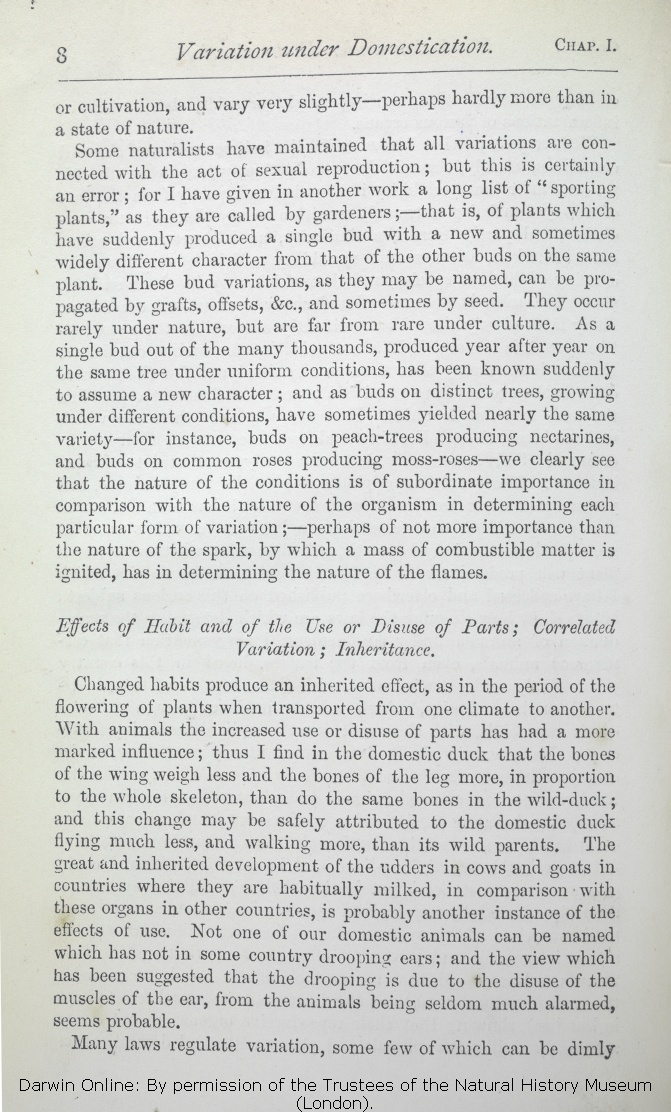Some naturalists have maintained that all variations are connected with the act of sexual reproduction; but this is certainly an error; for I have given in another work a long list of "sporting
plants;" | plants;" 1872 | | plants," 1869 |
| bud variations, 1872 | | bud-variations, 1869 |
| are far from rare 1872 |
| far from rarely 1869 |
| thousands, 1872 | | thousands 1869 |
| on the same tree under uniform conditions, 1872 |
| under uniform conditions on the same tree, 1869 |
| combustible 1872 | | bustible 1869 |
| Subtitle not present 1859 1860 1861 1866 1869 1872 |
|
|
| 9 blocks not present in 1869 1872; present in 1859 1860 1861 1866 | | Sterility has been said to be the bane of horticulture; but on this view we owe variability to the same cause which produces sterility; and variability is the source of all the choicest productions of the garden.
I may add, that as some organisms will breed most
freely under the most unnatural conditions (for instance, the rabbit and ferret kept in hutches), showing that their reproductive system has not been thus affected; so will some animals and plants withstand domestication or cultivation, and vary very slightly — perhaps hardly more than in a state of nature.
A long list could easily be given of "sporting plants;" by this term gardeners mean a single bud or offset, which suddenly assumes a new and sometimes very different character from that of the rest of the plant.
Such buds can be propagated by grafting, &c., and sometimes by seed.
These "sports" are extremely rare under nature, but far from rare under cultivation; and in this case we see that the treatment of the parent has affected a bud or offset, and not the ovules or pollen.
But it is the opinion of most physiologists that there is no essential difference between a bud and an ovule in their earliest stages of formation; so that, in fact, "sports" support my
view, that variability may be largely attributed to the ovules or pollen, or to both, having been affected by the treatment of the parent prior to the act of conception.
These cases anyhow show that variation is not necessarily connected, as some authors have supposed, with the act of generation.
Seedlings from the same fruit, and the young of the same litter, sometimes differ considerably from each other, though both the young and the parents, as Müller has remarked, have apparently been exposed to exactly the same conditions of life; and this shows how unimportant the direct effects of the conditions of life are in comparison with the laws of reproduction, and
of growth, and of inheritance; for had the action of the conditions been direct, if any of the young had varied, all would probably have varied in the same manner.
To judge how much, in the case of any variation, we should attribute to the direct action of heat, moisture, light, food, &c., is most difficult: my impression is, that with animals such agencies have produced very little direct effect, though apparently more in the case of plants.
|
| 1 blocks not present in 1866 1869 1872; present in 1859 1860 1861 | | Under this point of view, Mr. Buckman's recent experiments on plants seem
extremely valuable.
|
|
Changed habits produce an inherited effect, | Changed habits produce an inherited effect, 1872 |
| Habit also has a decided influence, 1859 1860 1861 1866 |
| Habits are inherited and have a decided influence; 1869 |
| the flowering of 1869 1872 |
| flowering with 1859 1860 1861 1866 |
| With 1872 | | In 1859 1860 1861 1866 1869 |
| the increased use or disuse of parts has had 1872 |
| it has 1859 1860 1861 1866 |
| they have 1869 |
| influence; thus 1872 |
| effect; for instance, 1859 1860 1861 1866 1869 |
| OMIT 1869 1872 |
| I presume that 1859 1860 1861 1866 |
| parents. 1869 1872 | | parent. 1859 1860 1861 1866 |
| OMIT 1872 |
| the state of 1859 1860 1861 1866 1869 |
| probably another 1866 1869 1872 | | another 1859 1860 1861 |
| effects 1866 1869 1872 | | effect 1859 1860 1861 |
| one of our 1869 1872 |
| a single 1859 1860 1861 1866 |
| animals 1869 1872 | | animal 1859 1860 1861 1866 |
| which has been suggested 1866 1869 1872 |
| suggested by some authors, 1859 1860 1861 |
| ..... 1866 1869 1872 | | not 1859 1860 1861 |
| seldom much alarmed, 1872 |
| much alarmed by danger, 1859 1860 1861 |
| seldom alarmed by danger, 1866 1869 |
|









